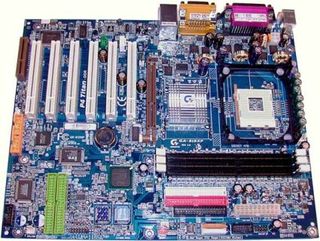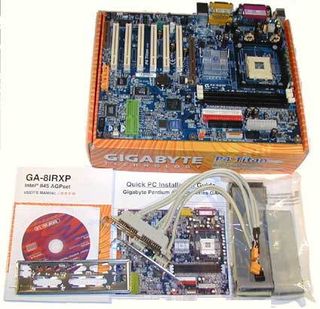Intel's Strike Force: 19 DDR-Motherboards With 845 Chipset and DDR-Support
Gigabyte GA-8IRXP P4 Titan

Board Revision: 2.0
BIOS Version: F4 (January 7, 2002)
Not only does Gigabyte have its own DualBIOS (a backup Flash ROM is present to keep the system running if the BIOS update procedure fails), it also has an excellent BIOS version from Award. In addition to the usual boot devices (floppy, all kinds of IDE drives, network), you can boot from USB. Also, interrupts can be assigned freely to each PCI device.
The CPU setup options are extremely valuable. There is a wide range of possible FSB speeds (100 to 200 MHz in 1 MHz increments), and you can increase the CPU core voltage and the AGP voltage in small increments. No other motherboard offers this variety of overclocking features, which is why we also used this one to run a Pentium 4 processor at above 3 GHz .
A PCI sound chip from Creative (CT5880) covers the sound for the latest games and applications. But that's not all, there is also a 100 Mbit network controller from Intel as well as an USB 2.0 controller from NEC. And, to top it off, this board comes with IDE RAID (Promise PDC20265R). In the end, it hardly seems possible to outnumber these features! The six PCI slots and three DIMM sockets look like cheap add-ons in comparison to these additonal features.
Running at 2196 MHz, Gigabyte sticks to the specifications for the test processor (Pentium 4 2.2 GHz).

Included in the package is an ATX cover (required for the network connector), one USB adapter for using the on-board USB ports 3 & 4, a second USB adapter for USB 2.0, two 80-pin IDE cables, one floppy cable, an excellent manual and a quick installation guide.
Stay on the Cutting Edge
Join the experts who read Tom's Hardware for the inside track on enthusiast PC tech news — and have for over 25 years. We'll send breaking news and in-depth reviews of CPUs, GPUs, AI, maker hardware and more straight to your inbox.
The GA-8IRXP was the first motherboard to run a Pentium 4 Northwood at over 3 GHz. Thanks to these outstanding overclocking abilities and the rich hardware features, we can only recommend the Gigabyte board.
Most Popular


